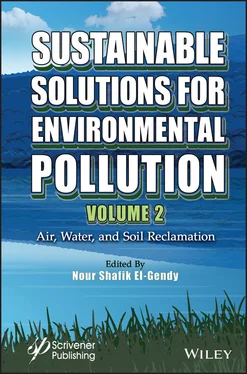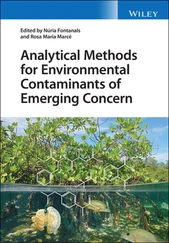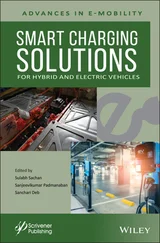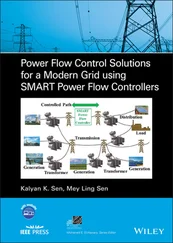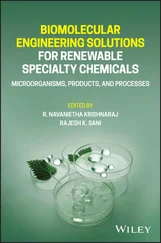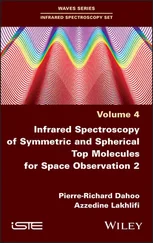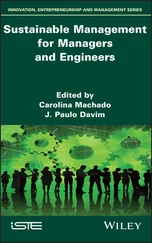Sustainable Solutions for Environmental Pollution, Volume 2
Здесь есть возможность читать онлайн «Sustainable Solutions for Environmental Pollution, Volume 2» — ознакомительный отрывок электронной книги совершенно бесплатно, а после прочтения отрывка купить полную версию. В некоторых случаях можно слушать аудио, скачать через торрент в формате fb2 и присутствует краткое содержание. Жанр: unrecognised, на английском языке. Описание произведения, (предисловие) а так же отзывы посетителей доступны на портале библиотеки ЛибКат.
- Название:Sustainable Solutions for Environmental Pollution, Volume 2
- Автор:
- Жанр:
- Год:неизвестен
- ISBN:нет данных
- Рейтинг книги:3 / 5. Голосов: 1
-
Избранное:Добавить в избранное
- Отзывы:
-
Ваша оценка:
- 60
- 1
- 2
- 3
- 4
- 5
Sustainable Solutions for Environmental Pollution, Volume 2: краткое содержание, описание и аннотация
Предлагаем к чтению аннотацию, описание, краткое содержание или предисловие (зависит от того, что написал сам автор книги «Sustainable Solutions for Environmental Pollution, Volume 2»). Если вы не нашли необходимую информацию о книге — напишите в комментариях, мы постараемся отыскать её.
This second volume in a broad, comprehensive two-volume set, “Sustainable Solutions for Environmental Pollution”, concentrates on air, water, and soil reclamation, some of the biggest challenges facing environmental engineers and scientists today.
AUDIENCE: Sustainable Solutions for Environmental Pollution,
Sustainable Solutions for Environmental Pollution, Volume 2 — читать онлайн ознакомительный отрывок
Ниже представлен текст книги, разбитый по страницам. Система сохранения места последней прочитанной страницы, позволяет с удобством читать онлайн бесплатно книгу «Sustainable Solutions for Environmental Pollution, Volume 2», без необходимости каждый раз заново искать на чём Вы остановились. Поставьте закладку, и сможете в любой момент перейти на страницу, на которой закончили чтение.
Интервал:
Закладка:
Table of Contents
1 Cover
2 Title Page
3 Copyright
4 Preface
5 1 Natural-Based Solutions for Bioremediation in Water Environment 1.1 Introduction 1.2 Basic Principles 1.3 Aquatic Bioremediation Structures 1.4 Constructed Porous Ramps 1.5 Bank Filtration for Water Treatment 1.6 Constructed Wetlands (CWs) 1.7 Phytoremediation and Constructed Wetlands 1.8 Phycoremediation 1.9 Phytoremediation 1.10 Improving Bioremediation Systems 1.11 Animal Biodiversity 1.12 Nuisances 1.13 Wetland Monitoring 1.14 Wetland Modeling 1.15 Social Acceptance 1.16 Ecohydrology, an Integrative NBS Implementation 1.17 Conclusion Acknowledgement References
6 2 Removal of Heavy Metals From the Environment by Phytoremediation and Microbial Remediation 2.1 Introduction 2.2 Linking Heavy Metals Toxicity With Their Discharge and Removal From the Environmental Compartments 2.3 Bio-Alternative Approaches Used for Heavy Metals Removal and/or Recovery From the Environment 2.4 Interactions of Heavy Metals With Biological Systems and Toxicity Threats 2.5 Synergistic Use of Plants and Bacteria for Cleaning Up the Environment Polluted With Heavy Metals 2.6 Conclusions Acknowledgments References Website
7 3 Bioremediation as a Sustainable Solution for Environmental Contamination by Petroleum Hydrocarbons 3.1 Introduction 3.2 Principles of Bioremediation 3.3 Bioremediation and Biodegradation 3.4 Mechanism of Biodegradation 3.5 Bioremediation of Land Ecosystems 3.6 Bioremediation of Water Ecosystems 3.7 Challenges and Opportunities References
8 4 Pollution Protection Using Novel Membrane Catalytic Reactors Nomenclatures Greek Letters Abbreviations 4.1 Introduction 4.2 Autothermal Systems 4.3 The Thermal Coupling and the Autothermal (Auto) Reactors 4.4 The Membrane Reactor 4.5 Development Fischer-Tropsch Synthesis 4.6 HTFT Reactor Type and Developments 4.7 Membrane Reactors Classification 4.8 Rate Expressions 4.9 Industrial Applications 4.10 Catalytic Membrane Reactors Coupling Dehydro of EB to S With Hydro NB to A as a Case Study 4.11 Case Study of Use the Membranes in Fischer-Tropsch Reactors 4.12 Biofuel and Sustainability 4.13 Conclusions References
9 5 Removal of Microbial Contaminants From Polluted Water Using Combined Biosand Filters Techniques 5.1 Introduction 5.2 Slow Sand Filtration 5.3 Wetlands 5.4 Combination of Sand Filters With Constructed Wetlands Systems 5.5 Conclusions References
10 6 Biosurfactants: Promising Biomolecules for Environmental Cleanup 6.1 Introduction 6.2 Biosurfactants Types 6.3 Biosurfactants Mechanism of Remediation 6.4 Bioremediation of Petro-Hydrocarbon Contaminants 6.5 Microbial Enhance Oil Recovery (MEOR) 6.6 Biosurfactants and Agro-Ecosystem Pollutants 6.7 Heavy Metals Removal 6.8 Biosurfactants for Sustainability 6.9 Production Processes 6.10 Concluding Remarks 6.11 Future Aspects References
11 7 Metal Hyperaccumulation in Plants: Phytotechnologies 7.1 Introduction 7.2 Phytotechnologies and Terminologies 7.3 Biological Mechanisms 7.4 Present Gaps and Prospects 7.5 Conclusion Acknowledgements References
12 8 Microbial Remediation Approaches for PAH Degradation 8.1 Introduction 8.2 Biogeochemical Properties and Sources of PAH 8.3 Fate of PAH 8.4 PAH: Soil and Air Pollution 8.5 Harmful Effects of PAH 8.6 Microbe Assisted Biodegradation 8.7 Genes and Enzymes Involved in Microbial Degradation 8.8 Factors Affecting Microbial Biodegradation 8.9 Bioremediation and Genetic Engineering 8.10 Conclusion and Future Prospects References
13 9 Biomorphic Synthesis of Nanosized Zinc Oxide for Water Purification 9.1 Introduction 9.2 Properties of ZnO NPs 9.3 Protocol for the Biosynthesis of ZnO NPs 9.4 Factors Affecting the Synthesis of ZnO Nanoparticles 9.5 Applications of Biologically Synthesized NPs 9.6 Mechanism of Biogenic Synthesis of ZnO NPs 9.7 Cytotoxicity of Nanoparticles 9.8 Conclusions and Future Outlook References
14 10 Pollution Dynamics of Urban Catchments 10.1 Introduction 10.2 Sustainability in Domestic Wastewater Treatment 10.3 Source Area Pollutant Generation Processes 10.4 Polluting Activities 10.5 Characterization of Urban Pollutants 10.6 The Fate and Transport of Urban Pollutants 10.7 Spatial Distribution of Urbans Pollutants 10.8 Case Study: City of Harare 10.9 Conclusions, Challenges, Opportunities, and/or Future Aspects References
15 11 Bioupgrading of Crude Oil and Crude Oil Fractions 11.1 Introduction 11.2 Microbial Enhanced Oil Recovery 11.3 Biotransformation of Heavy Crude Oil 11.4 Biorefining of Crude Oil 11.5 The Future of Biotechnology in the Refinery References
16 12 Recyclable Porous Adsorbents as Environmentally Approach for Greenhouse Gas Capture 12.1 Introduction 12.2 Classification of Porous Materials 12.3 Recyclability Routes of Biomass to Porous Carbons 12.4 Activation Routes Processes 12.5 CO 2Capture in Recyclable Porous Carbon Materials 12.6 CO 2Capture Mechanism in Porous Carbons 12.7 Prospects and Outlooks 12.8 Conclusion Acknowledgements References
17 About the Editor
18 Index
19 Also of Interest
20 Wiley End User License Agreement
List of Tables
1 Chapter 1 Table 1.1 Advantages and disadvantages of vertical and horizontal subsurface flo... Table 1.2 Interactions between the three nested logics of the aquatic biotope an...
2 Chapter 2Table 2.1 Summary of various researchers studies using microorganisms for the re...Table 2.2 Metal hyperaccumulating plants examples.Table 2.3 Some examples of obvious toxic symptoms induced by metals in plants (V...Table 2.4 List of studies featuring plant growth-promoting bacteria (PGRB) role ...Table 2.5 Enlisted studies of arbuscular mycorrhizal fungi (AMF)/fungi and its r...
3 Chapter 3Table 3.1 Essential factors for microbial bioremediation.Table 3.2 Advantages and disadvantages of bioremediation.
4 Chapter 4Table 4.1 Example of recuperative reactions.Table 4.2 Example of recuperative reactions with membrane.Table 4.3 Some examples of direct coupling.Table 4.4 Classification of membrane reactors.Table 4.5 Summary of the industrial applications of fluidized bed reactors.Table 4.6 Stoichiometric equations, heats of reactions, and reaction rate expres...Table 4.7 Frequency factors and activation energies for reactions considered.Table 4.8 Model equations for coupled catalytic membrane reactor.Table 4.9 The Dehydro and Hydro sides.Table 4.10 The possible roles of membranes in catalysis and some recent examples...
5 Chapter 6Table 6.1 Biosurfactant employed in the degradation of petro-hydrocarbons.Table 6.2 Application of biosurfactants in MEOR process.Table 6.3 Biosurfactant as biocontrol agents against plant pathogens.
6 Chapter 7Table 7.1 Terminologies used in phytotechnology.
7 Chapter 8Table 8.1 List of some parent and alkyl PAH with their structures.Table 8.2 Bacterial species and their genes involved in degradation of PAH.
8 Chapter 9Table 9.1 Biomorphic synthesis of ZnO NPs using different plant source with morp...
9 Chapter 12Table 12.1 CO 2adsorption capacities of activated porous carbons produced from d...
List of Illustrations
1 Chapter 1 Figure 1.1 Schematic organization of different microbial metabolic pathways in t... Figure 1.2 The OTHU self-purification device based on a porous wood weir. Figure 1.3 The basic principle of bank filtration. Figure 1.4 (a) Simplified scheme of a Free Surface Flow CW (SFS-CW); (b) Schemat... Figure 1.5 Various processes involved in phytoremediation of contaminants in aqu... Figure 1.6 (a) The 2-ha FSF-CW (Reims, France) in March 2020; (b) the UAV (Spybo... Figure 1.7 Monitoring the Reims FSF-CW with an aquatic drone. (a) Dissolved orga... Figure 1.8 Sentinel-2 True colour images of the St Just–St Nazaire de Pézan CW i... Figure 1.9 Monitoring of vegetation on the St Just–St Nazaire de Pézan CW using ... Figure 1.10 Sentinel-2 satellite view of the Tres Rios (Phoenix, Arizona) FSF-CW... Figure 1.11 Monitoring of Tres Rios fringing marshes using satellite images.  =... Figure 1.12 South African National Water Department’s approach to integrated wat... Figure 1.13 Logical nesting between levers (actions on forms, fluxes, and biocen... Figure 1.14 (a) illustration of balance and imbalance nutrient and biodegradatio... Figure 1.15 A pluvial runoff model can help identify which part of the basin is ...
=... Figure 1.12 South African National Water Department’s approach to integrated wat... Figure 1.13 Logical nesting between levers (actions on forms, fluxes, and biocen... Figure 1.14 (a) illustration of balance and imbalance nutrient and biodegradatio... Figure 1.15 A pluvial runoff model can help identify which part of the basin is ...
Интервал:
Закладка:
Похожие книги на «Sustainable Solutions for Environmental Pollution, Volume 2»
Представляем Вашему вниманию похожие книги на «Sustainable Solutions for Environmental Pollution, Volume 2» списком для выбора. Мы отобрали схожую по названию и смыслу литературу в надежде предоставить читателям больше вариантов отыскать новые, интересные, ещё непрочитанные произведения.
Обсуждение, отзывы о книге «Sustainable Solutions for Environmental Pollution, Volume 2» и просто собственные мнения читателей. Оставьте ваши комментарии, напишите, что Вы думаете о произведении, его смысле или главных героях. Укажите что конкретно понравилось, а что нет, и почему Вы так считаете.
